
Remember:
There are 3 kinds of Levers. Every kind of Lever has:
- a balance point (fulcrum)
- a point where the weight is
- a point where force is applied
Add these study questions in your notes as well as the following information on Levers.
1. Why is energy needed?
Energy is needed to do work.
2. How do scientists define “work”?
Work occurs when a force moves an object.
3. What is the difference between class 1, class 2, and class 3 levers?
A class-1 lever
has the fulcrum located somewhere between the effort and the load. With
this kind of lever, the direction of force is changes. Effort applied
downward moves the load up. Effort applied upward moves the load down.

A class-2 lever
has its fulcrum at one end of a lever arm. The load is between the
fulcrum and the effort. With this kind of lever, the direction of effort
is not changed. Pushing up on the class-2 lever arm pushes up on the
load. Pushing down on the lever arm pushes down on the load. To gain a
mechanical advantage, the load is places closer to the fulcrum than to
the effort. The class-2 lever always reduces effort.

In a class-3 lever,
the fulcrum is at one end, and the effort is applied between the
fulcrum and the load. With this kind of lever, the direction of effort
is not changed. The load moves in the same direction as the effort. The
gain offered by a class-3 lever is one of distance.

4. Explain why a simple machine makes work easier to do but does not save energy.Most simple machines do not save energy. They distribute the force needed to do work over a longer distance.
Generally,
simple machines can help us in two ways. We can apply less effort over a
greater distance, or we can apply more effort over a shorter distance.
Simple machines provide a gain in effort or a gain in distance. In
addition, some simple machines change the direction of effort.
5. How does a lever or pulley give you mechanical advantage?Sometimes
we may want to lift, push, or pull an objects, or we may need to break
or cut them. Some of these jobs require a lot of force. When we use
simple machines, we gain a mechanical advantage by increasing the amount
of force we can bring to bear on an object.
6. What is friction? When is it necessary to reduce friction?Friction is a force that slows down or stops motion. There is friction when two parts of a machine rub against each other.
One way to reduce friction is by covering surfaces that rub together with grease or oil. Another way is by using wheels.
7. What is the difference between a fixed and a movable pulley?A
fixed pulley can change the direction of your force. You pull down on
one end of the rope. The load is pulled up by the other end. It takes
the same force to lift a load with a fixed pulley as it does without a
fixed pulley.
A movable pulley does not change the direction of
your force. Like a lever, a movable pulley lets you use less force to
lift a load. But you must pull the rope a longer distance than the load
moves. The smaller force needed to lift a load with a movable pulley is
used over a longer distance. So a movable pulley does not save energy.
8. Where in real life can you find levers and pulleys?
- Examples of class-1 levers are: a seesaw, claw hammer, crowbar, scissors, pliers, and tin snips.
- Examples of class-2 levers are: a wheelbarrow, paper cutter, door, nutcracker, garlic press, bellows, and a bottle opener.
- Examples
of class-3 levers are: a fishing pole, hammer, baseball bat, hockey
stick, golf club, tennis racket, shovel, pitchfork, hoe, broom,
tweezers, ice tongs, and your arms and legs.
- Pulleys are used to lift items from one level to another.
- Pulleys can be fixed or movable or combinations of both.
- Pulleys are used in block and tackles, large cranes, chain hoists, and hydraulic systems.
9. TYPES OF LEVERS:
Levers are simple machines that have a rigid arm around a fixed point or fulcrum.
Force is transferred from one part of the arm to another.
- The input (effort) force is multiplied or redirected into anoutput (resistance) force.
- Levers are divided into three different classes.
- A first-class lever has the fulcrum between the input and output forces.
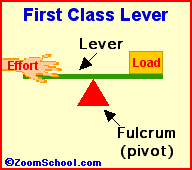
A Type 1 Lever. |
In a Type 1 Lever,
the pivot (fulcrum) is between the effort and the load. In an
off-center type one lever (like a pliers), the load is larger than the
effort, but is moved through a smaller distance.
Examples of common tools (and other items) that use a
Type 1 lever include:
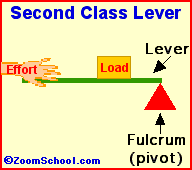
A Type 2 Lever. |
In a Type 2 Lever, the load is between the pivot (fulcrum) and the effort.
Examples of common tools that use a type 2 lever include:
| Item | Number of Class 2 Levers Used |
|---|
| stapler |  | a single class 2 lever |
| bottle opener |
| a single class 2 lever |
| wheelbarrow |  | a single class 2 lever |
| nail clippers |
| Two class 2 levers |
| nut cracker |
| Two class 2 levers |
The third-class lever has the input force between the fulcrum and the output force.
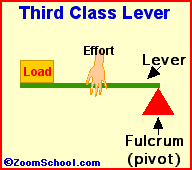
A Type 3 Lever. |
In a Type 3 Lever, the effort is between the pivot (fulcrum) and the load.
Examples of common tools that use a type 3 lever include:
| Item | Number of Class 3 Levers Used |
|---|
| fishing rod |  | a single class 3 lever |
| tweezers |
| Two class 3 levers |
| tongs |  | Two class 3 levers |
Different types of LEVERS into their appropriate classes.








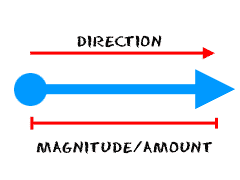 Force is one of many things that are vectors.
Force is one of many things that are vectors. 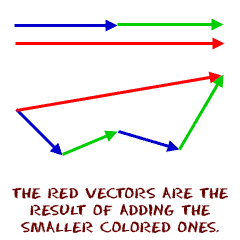 Imagine a situation where you're in a boat or a plane, and you need to plot a course. There aren't streets or signs along the way. You will need to plan your navigation on a map. You know where you're starting and where you want to be. The problem is how to get there. Now it's time to use a couple of vectors.
Imagine a situation where you're in a boat or a plane, and you need to plot a course. There aren't streets or signs along the way. You will need to plan your navigation on a map. You know where you're starting and where you want to be. The problem is how to get there. Now it's time to use a couple of vectors. 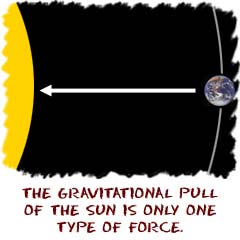 Forces are a big part of physics. Physicists devote a lot of time to the study of forces that are found everywhere in the universe.
Forces are a big part of physics. Physicists devote a lot of time to the study of forces that are found everywhere in the universe. 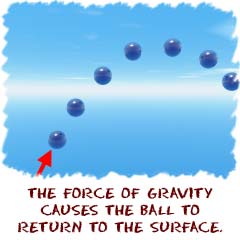
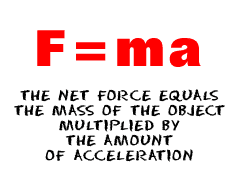 There is one totally important formula when it comes to forces, F = ma. That's all there is, but everything revolves around that formula.
There is one totally important formula when it comes to forces, F = ma. That's all there is, but everything revolves around that formula.